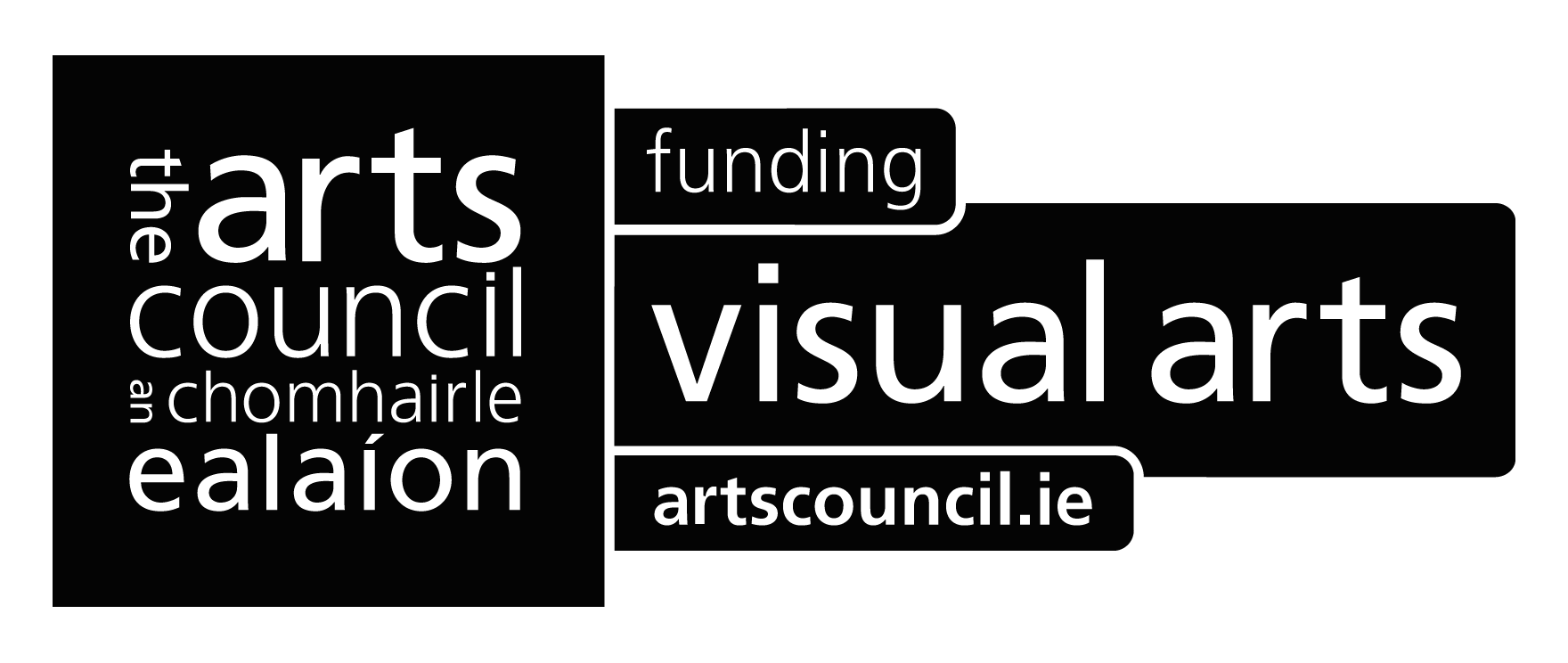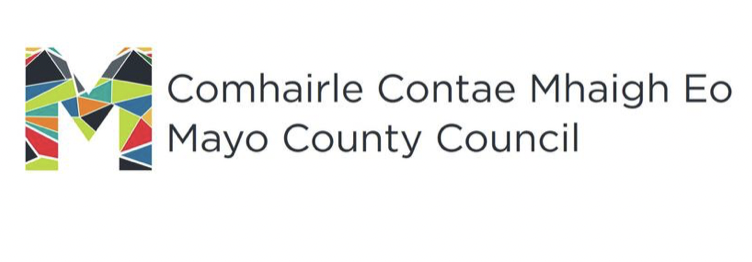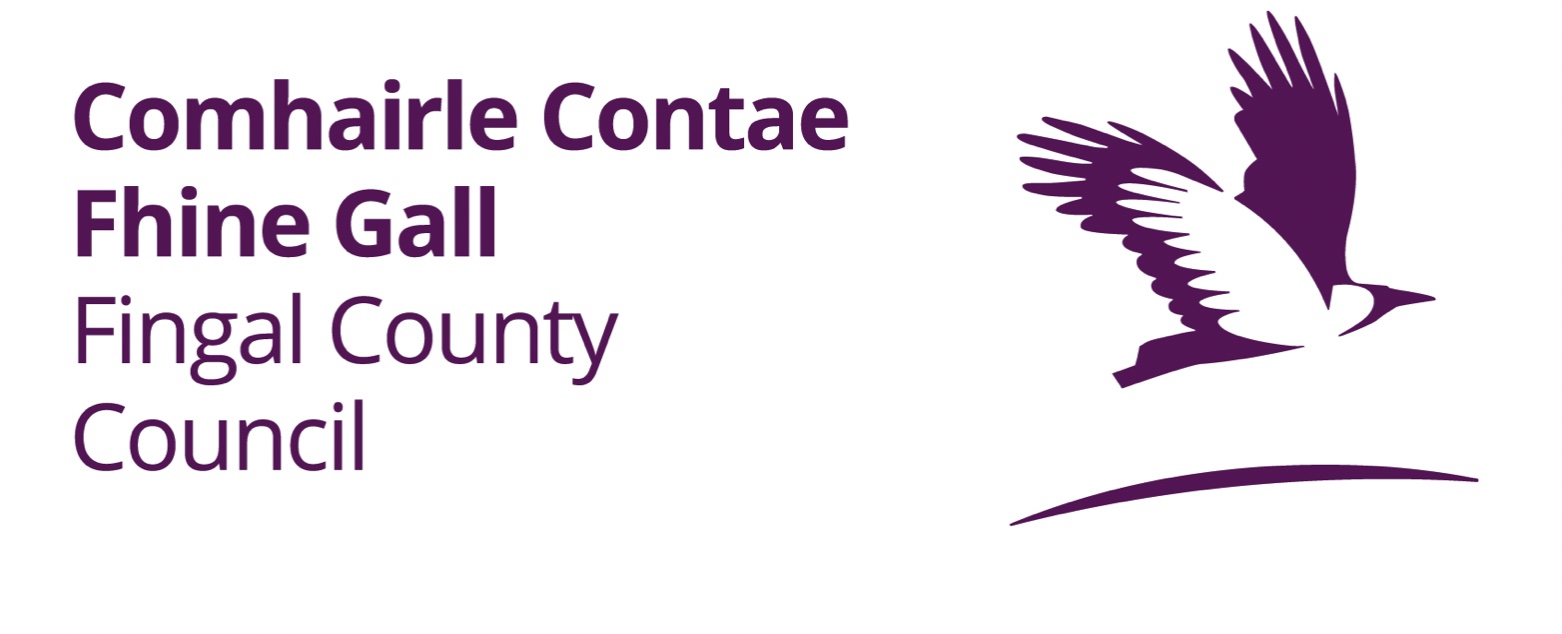Writing & Talks & Press
26 page artist book produced on the occasion of the Exhibition “Experiments and Considerations Touching Colours”
€20- (plus postage) email nualaclarke@gmail.com to order.
€20- (plus postage) email nualaclarke@gmail.com to order.
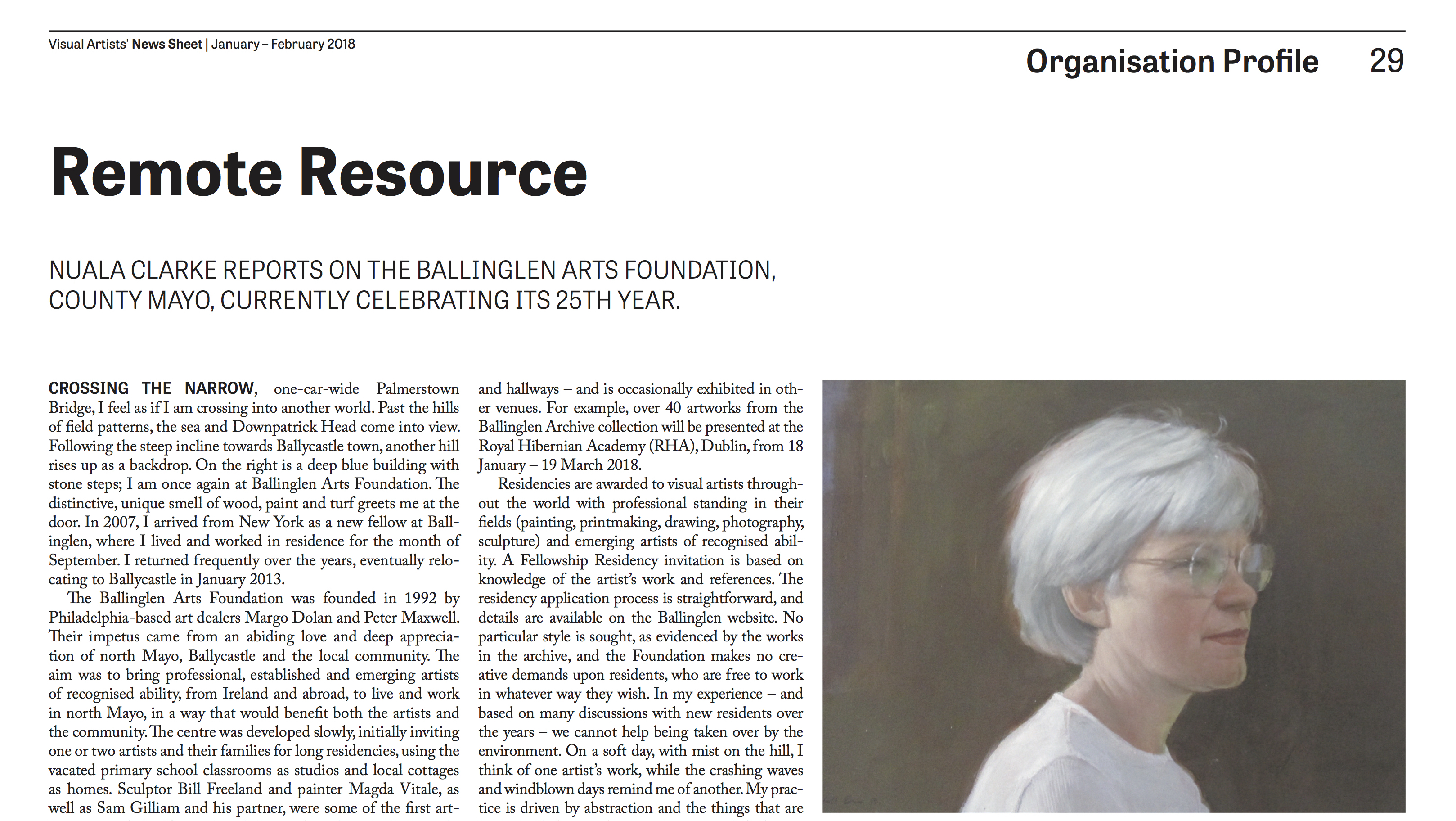
Visual Artists' News Sheet | January – February 2018
Organisation Profile 29
Remote Resource
NUALA CLARKE REPORTS ON THE BALLINGLEN ARTS FOUNDATION, COUNTY MAYO, CURRENTLY CELEBRATING ITS 25TH YEAR.
CROSSING THE NARROW, one-car-wide Palmerstown Bridge, I feel as if I am crossing into another world. Past the hills of eld patterns, the sea and Downpatrick Head come into view. Following the steep incline towards Ballycastle town, another hill rises up as a backdrop. On the right is a deep blue building with stone steps; I am once again at Ballinglen Arts Foundation. The distinctive, unique smell of wood, paint and turf greets me at the door. In 2007, I arrived from New York as a new fellow at Ballinglen, where I lived and worked in residence for the month of September. I returned frequently over the years, eventually relocating to Ballycastle in January 2013.
The Ballinglen Arts Foundation was founded in 1992 by Philadelphia-based art dealers Margo Dolan and Peter Maxwell. Their impetus came from an abiding love and deep appreciation of north Mayo, Ballycastle and the local community. The aim was to bring professional, established and emerging artists of recognised ability, from Ireland and abroad, to live and work in north Mayo, in a way that would benefit both the artists and the community. The centre was developed slowly, initially inviting one or two artists and their families for long residencies, using the vacated primary school classrooms as studios and local cottages as homes. Sculptor Bill Freeland and painter Magda Vitale, as well as Sam Gilliam and his partner, were some of the first artists to spend significant time living and working in Ballycastle. From the beginning, Ballinglen not only allowed but encouraged families and friends to come with artists or to visit them. Arrangements are often made for school-age children to enrol in the local schools. As a result, almost 4000 visitors spend time in Ballycastle each year, providing direct socio-economic benefit to this rural community.
The two-storey Foundation Building – designed by Peter Maxwell and completed in 1996-97 – houses the administrative offices and studios. A series of buildings, in keeping with the architectural style of Main Street, creates a striking and memorable environment. The attention to detail and materials used set up an aesthetic entirely conducive to creativity. Each visiting artist is assigned a studio in the building.
There are four functionally designed studios on the top floor, with skylights allowing plenty of natural light. At the end of the corridor, there is a sunroom, otherwise known as the drawing porch, offering views of the sweep to the sea, which never fails to enrapture. The print studio on the ground floor, again lit with natural light and insulated with wood cladding, is a well-equipped and gorgeous space to work in.
Housing a significant collection of art and design books, the Dolan/Maxwell Library is a warm and quiet nook overlooking the street, which is perfect for research and creative centring.
A vernacular courthouse, owned and renovated by the foundation, functions as the Ballinglen Gallery. The latest addition to the centre is a large workshop area in the garden, used for master- class, workshops and other group learning activities.
Ballinglen is governed by a board of directors comprising seven members from arts and business fields. e organisation is funded by the Irish Arts Council, Mayo County Council and private national and international donations. In 2013, due to funding cuts, Ballinglen began offering a two-week-long masterclass with painters Randall Exon and Jeffrey Reed. This has since evolved into a year-long programme of workshops taught by Ballinglen Fellows that attracts learners from around the world. The centre is staffed by two full-time local employees: Una Forde, Managing Director; and Christine Tighe, Buildings and Accounts Supervisor. Six participants from the Rural Social Scheme are involved in the upkeep and day-to-day running of the facilities and cottages. Three volunteers were in attendance in 2017, including a library archivist who documented the donation by President Mary Robinson and Nick Robinson of their art book collection.
Ballinglen Fellows are given cottages for living and purpose-built studios for working which are free of any charges during their first visit. Fellows are encouraged to experience the local rural community, its churches, shops, pubs and its people. The founders believed that this kind of interaction “invigorates the spirit”, reminding us of what it is “to be a human being”. They found the landscape and weather uniquely inspiring and the community, equally so. A major component of the Fellowship Programme is each artist’s exploration of the north Mayo region. Each Ballinglen Fellow, as a condition of their first four to six-week residency, gifts a piece of work to the Ballinglen Archive. is work is regularly displayed throughout the building – in the Common Room, offices
and hallways–and is occasionally exhibited in other venues.
For example, over 40 artworks from the Ballinglen Archive collection will be presented at the Royal Hibernian Academy (RHA), Dublin, from 18 January – 19 March 2018.
Residencies are awarded to visual artists through-out the world with professional standing in their fields (painting, printmaking, drawing, photography, sculpture) and emerging artists of recognised abiity. A Fellowship Residency invitation is based on knowledge of the artist’s work and references. The residency application process is straightforward, and details are available on the Ballinglen website. No particular style is sought, as evidenced by the works in the archive, and the Foundation makes no creative demands upon residents, who are free to work in whatever way they wish. In my experience – and based on many discussions with new residents over the years we cannot help being taken over by the environment. On a soft day, with mist on the hill, I think of one artist’s work, while the crashing waves and windblown days remind me of another. My practice is driven by abstraction and the things that are intrinsically known, but remain unseen. I find sympathetic companions among the new and returning residents of Ballinglen. It is a unique situation to be in: both out in the most remote environment, yet in a creative hub of process and activity.
Working in close collaboration with the area’s national and secondary schools, as well as third level institutions, the foundation has developed a successful Schools Programme. I have taken on the role of Education Facilitator in the last few years. Each year, over twenty classes from local schools come to Ballinglen for a day of hands-on art-making and tours of the gallery and studios. As a resident, I looked forward to visits from these small, honest, engaged and curious children. I believe that it is important for children to see artists at work – it opens possibilities for them. This year, to celebrate the 25th anniversary of the Ballinglen Arts Foundation, we are exhibiting prints made by the 450 school children who visited in 2017. On 2 December we open the doors to the community, offering events such as craft workshops and studio tours with the five current visiting artists.
A relatively new programme of week-long workshops for adults has been organised by e Artist in Rural Ireland Fund for the last four years. These are led by internationally renowned artists who are fellows of the foundation, offering access to quality short- term education. Details of the 2018 workshop programme are available at: ballinglenworkshops.com.
Ballinglen is a valuable part of the thriving visual arts community of Mayo – a county replete with many resident artists, a strong and innovative County Council Arts Office and a network of art centres that communicate well with each other. e Mayo Arts Collaborative consists of: Linenhall Arts Centre, Castlebar; Custom House Gallery, Westport; Áras Inis Gluaire, Belmullet; Ballinglen Arts Foundation; and Ballina Arts Centre. In 2016 Catherine Marshall curated the exhibition ‘Kathleen Lynn: In- sider on the Outside’ which ran concurrently in the five venues listed, displaying work by 13 contemporary Irish artists.
Ballinglen plans to add another facet to its operation and has obtained planning permission for the construction of the Museum of Contemporary Art at the Ballinglen Arts Foundation. Ballinglen received a grant of €200,000 under the Rural Town & Regeneration Scheme and will begin in early 2018 with the demolition of an adjacent derelict building and the construction of a two-storey museum on Main Street in Ballycastle. It will consist of an exhibition space, education centre, print gallery, ar- chive and meeting rooms. e museum will house the 630 works in the Ballinglen Archive and will ensure that the collection can be permanently available for the viewing public and for curatorial purposes. On 22 January 2018 at 2pm there will be a fundraising draw to match the funds awarded by the Regeneration Scheme. All work in the draw has been donated by Ballinglen Fellow artists who are members of the RHA. You may purchase tickets to have a chance of winning a painting by one or more leading Irish artists. All proceeds from ticket sales go toward construction and every cent is needed: ballinglenmuseumfundraiser.weebly.com
Nuala Clarke is an Irish visual artist who relocated from New York to Ballycastle in 2013.
Painting and Not Painting
BYU Kennedy Center
2017
BYU Kennedy Center
2017
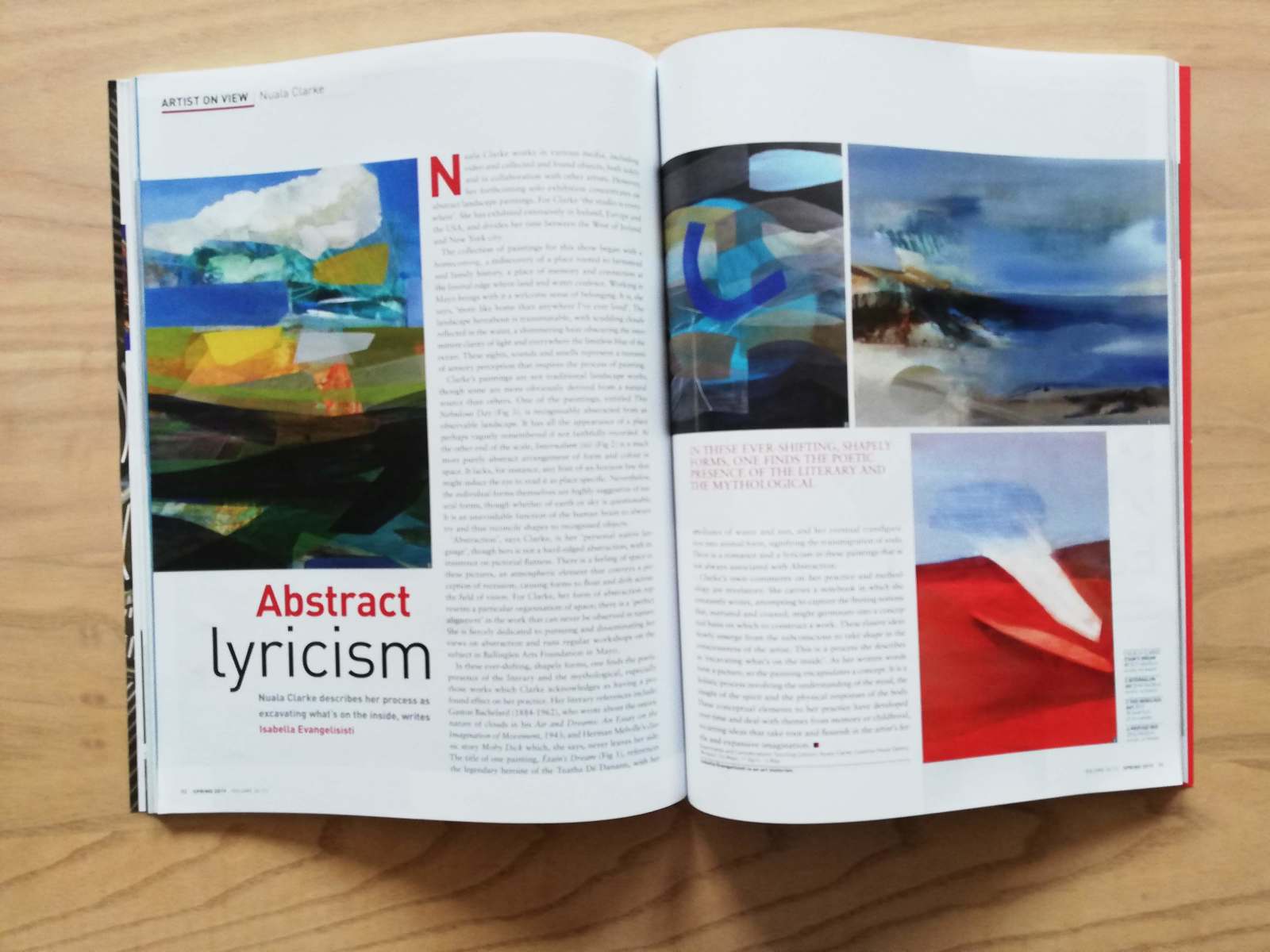
Titling a Painting
Putting a title on a painting is a peculiar affair. Paintings are wordless objects, being just themselves, not standing for anything but themselves. It can appear as if the words in a title are a descriptor or explainer of sorts, they are often thought of as a sign pointing to that which is unconcerned with signs. Convention asks that we have some way of identifying these painted objects for purpose of convenience, cataloguing, presenting and such.
I go along with this for the most part because I'm partial to the usefulness of words, derive joy from their precise meanings and their potential for turning us verbal creatures toward the spark, doubling the depth. In the case of some paintings a title is picked so that it will do the least damage by its addition, by neither illuminating or obscuring the image it accompanies. Other paintings announce their titles within the 1st moments of creation, these are the helpful ones, co-creators, all my decisions are thereafter clear. The title is the leader and guide, I merely keep pace and proceed accordingly. The title and object are melded, inseparable. And then there is the truly wordless painting, the one which for longer than is convenient remains in the realm of "untitled". unattached. what then? Oh by god sometimes it is stubborn; a painting which may heretofore have shown no resistance will not, at this last moment, concede to flattery; will not let itself be pinned down. Take the painting "untitled" for example. It has yet to give up its wordless stance, tells me it's too big for any mere word or series of words, poetry pish. It also .. doesn't appreciate being photographed, doesn't feel as if justice is being done. Oh ! - now - wait -has it told me something? Dictionary. Justice: rightfulness, conformity, the quality of being just, righteousness. Just: guided by truth, reason, fairness, done or made according to principle. Principle: a determining characteristic of something, essential quality. Ah, if i am listening correctly this painting is telling me it belongs to a subset of paintings that are elemental. I know from experience that to call it "elemental" is to make a mockery, lessen it somehow, for always to speak of the truth is to lessen the truth. For now, I must place a date and time after the word untitled. This painting gives way to that, tells me that to document the occurrence of its creation within the predetermined systems of this place and time is the harmless solution because of the very arbitrary nature of all that malarkey anyway.
2009
Starting a Painting
Starting a painting is not so much a decision these days as something which occurs. To begin with some sort of movement must happen, some sort of organisational or preparatory process be initiated. I must be in the room; with time and material; get up from the screen, chair, bench. The move then is from the finite space to the space with more blossom in it. I find the smoothest transition from the one to the other occurs in the act of sweeping. Brush in hand, sweep out the corners, push the inevitable sand around. I don't gather up, that's something else, not part of this particular thing. Where the switch happens I'm not sure; I find myself having started sweeping now painting. Transition invisible. This mundane organisational task is conducive to beginning, properly, a painting which requires "work". One in a line of paintings, where the material is familiar. The ones which must be done.
If now, I sense there's a chance to make something new; to make a connection between two previously unconnected parts, tidying, not sweeping is the fore-bearer of this activity. The bits and pieces necessary are scattered around the space, inconveniently unnamed as “necessary parts of a new work” and so walk, pick, place, take, pile, lift, look, note, stride, note, write, spin, gesture, ah, here, no, yes, yes! Parts come together as if they always were.
Another exception, another if, is for the monumental, cumulative painting. Its arrival can be perceived by the quality of brewing. For this work the ground must be prepared, the room cleared and then left, vacated. This luminary will not live from a measured start. It comes with gasps and foot stampings, air breathed in and out irregularly. Careful, for more than once a leviathan has become a fossil from too sensible a start.
When I draw, objects on the desk form a line, piles of things are straight. Paring all the pencils in the cup is the fore-bearing activity here. Ah now, let me not give every bit of it away just yet, pale up the illusion for you. All this is a precarious oul business. If I'm doing something right the work will likely have some unrecognisable aspect; be mystifying to me. I stand back, end of day with no answers to bring home. For twenty years I've done this and it's never a given; not even once do I start something with a guarantee that what I "know" will come with me; when it does I greet the ease with relief and continue.
2010
Putting a title on a painting is a peculiar affair. Paintings are wordless objects, being just themselves, not standing for anything but themselves. It can appear as if the words in a title are a descriptor or explainer of sorts, they are often thought of as a sign pointing to that which is unconcerned with signs. Convention asks that we have some way of identifying these painted objects for purpose of convenience, cataloguing, presenting and such.
I go along with this for the most part because I'm partial to the usefulness of words, derive joy from their precise meanings and their potential for turning us verbal creatures toward the spark, doubling the depth. In the case of some paintings a title is picked so that it will do the least damage by its addition, by neither illuminating or obscuring the image it accompanies. Other paintings announce their titles within the 1st moments of creation, these are the helpful ones, co-creators, all my decisions are thereafter clear. The title is the leader and guide, I merely keep pace and proceed accordingly. The title and object are melded, inseparable. And then there is the truly wordless painting, the one which for longer than is convenient remains in the realm of "untitled". unattached. what then? Oh by god sometimes it is stubborn; a painting which may heretofore have shown no resistance will not, at this last moment, concede to flattery; will not let itself be pinned down. Take the painting "untitled" for example. It has yet to give up its wordless stance, tells me it's too big for any mere word or series of words, poetry pish. It also .. doesn't appreciate being photographed, doesn't feel as if justice is being done. Oh ! - now - wait -has it told me something? Dictionary. Justice: rightfulness, conformity, the quality of being just, righteousness. Just: guided by truth, reason, fairness, done or made according to principle. Principle: a determining characteristic of something, essential quality. Ah, if i am listening correctly this painting is telling me it belongs to a subset of paintings that are elemental. I know from experience that to call it "elemental" is to make a mockery, lessen it somehow, for always to speak of the truth is to lessen the truth. For now, I must place a date and time after the word untitled. This painting gives way to that, tells me that to document the occurrence of its creation within the predetermined systems of this place and time is the harmless solution because of the very arbitrary nature of all that malarkey anyway.
2009
Starting a Painting
Starting a painting is not so much a decision these days as something which occurs. To begin with some sort of movement must happen, some sort of organisational or preparatory process be initiated. I must be in the room; with time and material; get up from the screen, chair, bench. The move then is from the finite space to the space with more blossom in it. I find the smoothest transition from the one to the other occurs in the act of sweeping. Brush in hand, sweep out the corners, push the inevitable sand around. I don't gather up, that's something else, not part of this particular thing. Where the switch happens I'm not sure; I find myself having started sweeping now painting. Transition invisible. This mundane organisational task is conducive to beginning, properly, a painting which requires "work". One in a line of paintings, where the material is familiar. The ones which must be done.
If now, I sense there's a chance to make something new; to make a connection between two previously unconnected parts, tidying, not sweeping is the fore-bearer of this activity. The bits and pieces necessary are scattered around the space, inconveniently unnamed as “necessary parts of a new work” and so walk, pick, place, take, pile, lift, look, note, stride, note, write, spin, gesture, ah, here, no, yes, yes! Parts come together as if they always were.
Another exception, another if, is for the monumental, cumulative painting. Its arrival can be perceived by the quality of brewing. For this work the ground must be prepared, the room cleared and then left, vacated. This luminary will not live from a measured start. It comes with gasps and foot stampings, air breathed in and out irregularly. Careful, for more than once a leviathan has become a fossil from too sensible a start.
When I draw, objects on the desk form a line, piles of things are straight. Paring all the pencils in the cup is the fore-bearing activity here. Ah now, let me not give every bit of it away just yet, pale up the illusion for you. All this is a precarious oul business. If I'm doing something right the work will likely have some unrecognisable aspect; be mystifying to me. I stand back, end of day with no answers to bring home. For twenty years I've done this and it's never a given; not even once do I start something with a guarantee that what I "know" will come with me; when it does I greet the ease with relief and continue.
2010
 untitled 9-15-10-25 2011 ballycastle
untitled 9-15-10-25 2011 ballycastle